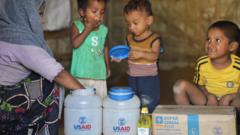Could Trump's Global Aid Cuts Lead to 14 Million Deaths in Five Years?

Understanding the Impact of Cuts to US Foreign Humanitarian Aid
The recent decision by the Trump administration to drastically reduce funding for foreign humanitarian aid is raising alarms among health experts and humanitarian organizations worldwide. According to a study published in The Lancet medical journal, this move could lead to more than 14 million additional deaths by 2030, primarily affecting vulnerable populations such as children. This article delves into the implications of these funding cuts, exploring the potential consequences for global health, humanitarian efforts, and the well-being of millions of individuals in low- and middle-income countries.
The Scope of US Humanitarian Aid
The United States has long been recognized as the largest provider of humanitarian aid globally, operating in over 60 countries and playing a crucial role in alleviating suffering in crisis situations. Through the United States Agency for International Development (USAID), the US has funded various health programs, food assistance initiatives, and emergency relief efforts, which have collectively saved millions of lives. Between 2001 and 2021, USAID funding is estimated to have prevented approximately 91 million deaths in developing nations.
The Role of USAID in Global Health
USAID's efforts have been instrumental in combating infectious diseases, improving maternal and child health, and enhancing nutritional outcomes. Some key areas where USAID has made a significant impact include:
- Infectious Disease Control: Programs aimed at controlling diseases such as HIV/AIDS, malaria, and tuberculosis have saved countless lives.
- Maternal and Child Health: Initiatives to improve maternal health and reduce child mortality rates have been crucial in many developing nations.
- Food Security: Food assistance programs have helped mitigate hunger and malnutrition, particularly in areas affected by conflict and disaster.
The Implications of Funding Cuts
With the announcement of an 83% cut in funding from USAID, the implications for global health and humanitarian assistance are profound. Experts warn that these cuts could result in a public health crisis comparable to a global pandemic or a major armed conflict. The following sections outline the potential consequences of these funding reductions.
Increased Mortality Rates
The research from The Lancet highlights alarming projections regarding avoidable deaths. The study indicates that:
- More than 14 million additional deaths could occur by 2030 due to funding cuts.
- Over 4.5 million of these deaths are expected to be children under the age of five, which translates to approximately 700,000 child deaths annually.
Reversal of Progress in Health
For the past two decades, there has been significant progress in health outcomes among vulnerable populations in developing countries. However, the proposed cuts risk reversing this progress, potentially halting advancements in maternal and child health, nutrition, and disease control. This regression could lead to higher incidences of preventable diseases and increased child mortality rates.
The Humanitarian Crisis Unfolding
As funding decreases, the situation on the ground is deteriorating. Reports from UN officials indicate that many communities are facing extreme levels of food insecurity and malnutrition. For instance, in Kenyan refugee camps, food rations have been reduced to their lowest levels ever, leading to alarming rates of starvation among vulnerable populations.
Case Study: The Situation in Kenya
In Kakuma, a refugee camp in northwestern Kenya, the effects of funding cuts are evident. A recent report described a baby suffering from severe malnutrition, showcasing the dire consequences of reduced aid. Such scenarios are becoming increasingly common as humanitarian organizations struggle to meet the needs of those who rely on international support.
The Political Landscape and Its Consequences
The cuts to USAID funding have been framed within a broader political context. Advocates for the cuts argue that they aim to streamline government operations and reduce waste. However, critics contend that these actions disproportionately affect the world's most vulnerable populations, prioritizing cost-cutting over humanitarian needs. US Secretary of State Marco Rubio has stated that the administration plans to focus on a smaller number of programs, claiming that they will be administered "more effectively" under the State Department.
Global Reactions to Funding Cuts
International leaders and humanitarian organizations express deep concern over the potential ramifications of these funding reductions. During a recent UN-led aid conference in Seville, the gravity of the situation was underscored by numerous world leaders calling for sustained support for humanitarian efforts. The sentiment is clear: reducing US funding for foreign aid could have catastrophic effects on global health and security.
Long-Term Consequences for Global Health
The cuts to USAID funding not only threaten immediate humanitarian needs but also have long-term implications for global health systems. As health programs face funding shortages, the ability to respond to emerging health threats, such as pandemics or disease outbreaks, is compromised. The failure to support robust health systems in developing countries can lead to a cycle of crisis, where health emergencies escalate due to lack of preparedness and resources.
Addressing the Root Causes of Vulnerability
Humanitarian aid is not just about providing immediate relief; it is also about addressing the root causes of vulnerability. Effective aid programs focus on building resilience, improving infrastructure, and promoting sustainable development. Cuts to funding can undermine these efforts, leaving communities ill-equipped to face future challenges.
Conclusion: The Need for Continued Support
The decision to cut funding for foreign humanitarian aid has far-reaching consequences that extend beyond borders. The potential for millions of avoidable deaths, particularly among children, underscores the urgent need for a reassessment of these policies. As the world grapples with ongoing humanitarian crises exacerbated by conflict, climate change, and economic instability, the need for sustained and effective humanitarian assistance has never been clearer.
In light of the evidence presented, it is imperative for policymakers to recognize the importance of maintaining funding for USAID and other humanitarian programs. The stakes are high, and the lives of millions depend on it. As global citizens, we must advocate for policies that prioritize human life and dignity, ensuring that vulnerable populations receive the support they need to thrive.
FAQs
What are the main reasons for the cuts to USAID funding?
The cuts are part of a broader initiative by the Trump administration aimed at streamlining government operations and reducing federal spending. Critics argue that these measures disproportionately impact vulnerable populations in developing countries.
How many lives could be affected by these funding cuts?
Research indicates that the cuts could lead to more than 14 million additional deaths by 2030, with over 4.5 million of those expected to be children under the age of five.
What can be done to mitigate the impact of funding cuts on humanitarian aid?
Advocacy for sustained funding, increased awareness about the consequences of these cuts, and collaboration between governments, NGOs, and international organizations are essential to mitigate the impact of funding reductions.
As we navigate these complex issues, it is crucial to reflect on our collective responsibility towards vulnerable populations. What actions can we take to ensure that humanitarian aid remains a priority in a changing political landscape? #HumanitarianAid #GlobalHealth #ChildMortality
Published: 2025-07-01 03:23:05 | Category: world



